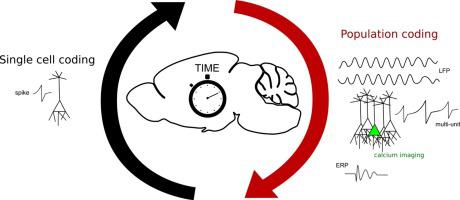Neuroscience & Biobehavioral Reviews ( IF 8.2 ) Pub Date : 2020-05-19 , DOI: 10.1016/j.neubiorev.2019.12.033 Lucille Tallot 1 , Valérie Doyère 2

|
The processing of temporal intervals is essential to create causal maps and to predict future events so as to best adapt one’s behavior. In this review, we explore the different brain activity patterns associated with processing durations and expressing temporally-adapted behavior in animals. We begin by describing succinctly some of the current models of the internal clock that can orient us in what to look for in brain activity. We then outline how durations can be decoded by single cell activity and which activity patterns could be associated with interval timing. We further point to similar patterns that have been observed at a more global level within brain areas (e.g. local field potentials) or, even, between these areas, that could represent another way of encoding duration or could constitute a necessary part for more complex temporal processing. Finally, we discuss to what extent neural data fit with internal clock models, and highlight improvements for experiments to obtain a more in-depth understanding of the brain’s temporal encoding and processing.
中文翻译:

动物大脑中时间的神经编码。
时间间隔的处理对于创建因果图和预测未来事件以最佳地适应人的行为至关重要。在这篇综述中,我们探索了与加工持续时间相关的不同大脑活动模式,并表达了动物的时间适应行为。我们首先简要描述内部时钟的一些当前模型,这些模型可以使我们确定要寻找的大脑活动。然后,我们概述了如何通过单个单元格活动来解码持续时间,以及哪些活动模式可以与间隔时间相关联。我们进一步指出,在大脑区域内(例如局部场电势)甚至在这些区域之间,在全球范围内观察到的相似模式,可以代表编码持续时间的另一种方式,也可以构成更复杂的时间处理的必要部分。最后,我们讨论了神经数据在多大程度上适合内部时钟模型,并重点介绍了对实验的改进,以更深入地了解大脑的时间编码和处理。


























 京公网安备 11010802027423号
京公网安备 11010802027423号